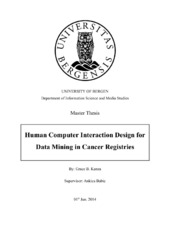Human computer interaction design for data mining in cancer registries
Master thesis
Permanent lenke
https://hdl.handle.net/1956/8293Utgivelsesdato
2014-06-01Metadata
Vis full innførselSamlinger
Sammendrag
Cancer registries are created, managed and data mined to gain knowledge about long-term outcomes, effects of the medication and clinical factors influencing the patient well-being. Such clinical registries have been a good source of information and are used for research purposes in areas such as epidemiological research and healthcare planning and monitoring for evaluating and planning cancer control programs across the different regions. They contain a lot of data that require good visualisation techniques in order to extract meaning. Interest among different user groups (clinicians, medical students, and the public) creates expectations regarding the results and active role in the development and interactive use of the information. Following the need for flexible and easy to use user interfaces, this thesis looks at reports based on the data mined from the Swedish Cancer Registry as a starting point in suggesting how this data could be presented to the audience in smart and user-friendly interfaces that enhance the utilization of information kept in such data resources. Personal Kanban was used to manage the design process, which combined Parallel and Iterative design process models for designing a prototype solution. The resulting prototype provided users with a choice of several data visualisation possibilities following the users' tasks and goals. Heuristic evaluation with experts was used to evaluate elements of the user interfaces. The prototype had high scores on all the design dimensions: visibility of system status; match between the system and the real world; user control and freedom; consistency and standards; error prevention; recognition rather than recall; flexibility and efficiency of use; aesthetic and minimalist design; help users recognize, diagnose, and recover from errors; and help and documentation.
